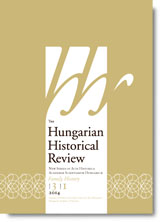Betrothal and Wedding, Church Wedding and Nuptials: Reflections on the System of Marriages in Sixteenth- and Seventeenth-Century Hungary
Betrothal and Wedding, Church Wedding and Nuptials: Reflections on the System of Marriages in Sixteenth- and Seventeenth-Century Hungary
Author(s): András Péter SzabóSubject(s): History
Published by: Magyar Tudományos Akadémia Bölcsészettudományi Kutatóközpont Történettudományi Intézet
Summary/Abstract: The aim of the present study is to sketch briefly the relationship between the ecclesiastical and secular elements of the marriage customs in the sixteenth- and seventeenth-century Kingdom of Hungary and Principality of Transylvania with the help of the sixteenth-century nuptial invitations preserved in the town archives of Beszterce (German: Bistritz; today Bistriţa, Romania), the specialist literature and ethnographic analogies. The common Hungarian and Latin designation for the betrothal and the church marriage (kézfogás/desponsatio) indicates that the two concepts had not separated completely. The terminological uncertainty can be explained by the slow implementation of canonical requirements: in practice the betrothal, adopted in the twelfth century, originating in Roman law, only gradually earned its place. The Reformation gave further impetus to doctrines proclaiming the binding force of betrothal, perhaps also connected with this is the fact that a binding form of betrothal also existed alongside that corresponding to today’s version for a very long time in both Transylvania and Hungary. Betrothal accompanied by church ceremony in this case was followed as a second phase by a purely secular wedding feast. Only after the wedding subsequently became permanently embedded in the wedding feast did the church ceremony become the central element in the series of events.
Journal: The Hungarian historical review : new series of Acta Historica Academiae Scientiarum Hungaricae
- Issue Year: 3/2014
- Issue No: 1
- Page Range: 3-31
- Page Count: 29
- Language: English

